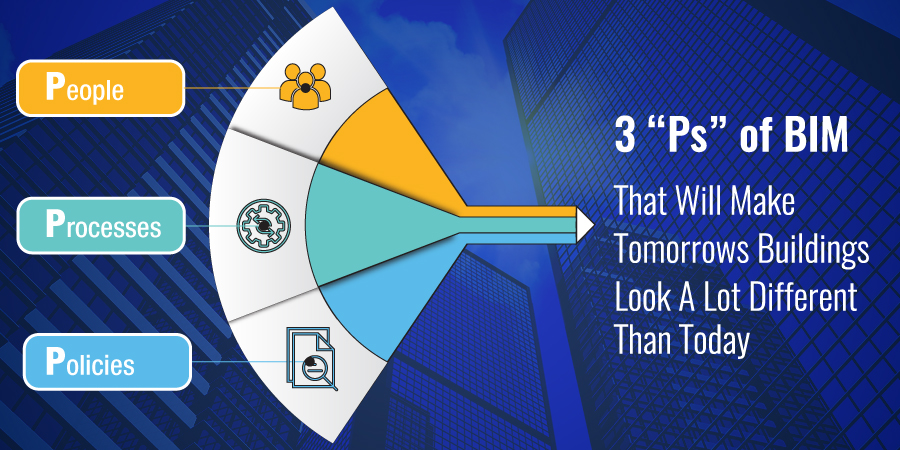Successfully implementing BIM relies on the 3 P’s of BIM: people, processes and policies. Gaurang Trivedi, Engineering Consultant for TrueCADD explains
Advances in technology have impacted virtually every sphere of life, where Radio Shack stores have been replaced by cloud service providers like Google and Amazon, Netflix has replaced Blockbuster, and smartphones have successfully replaced Polaroid cameras. The scenario in the architecture, engineering and construction (AEC) fraternity is no different where BIM is all set to replace CAD for planning, designing and modelling AEC projects.
BIM is taking the architectural practice a step further
BIM is the stepping stone helping the AEC industry to progress, along with the technological evolution called generative design. The beauty is that specific constraints and objectives such as daylight, thermal performance and structural integrity, are taken into consideration by computer software algorithms to leverage BIM and help architects in generating computational or parametric building designs.
Some of the software algorithms of generative design are apt at manipulating building data to deliver more than 17,000 different design options in a mere few days. With the automation of design optimisation, computers are now capable of sorting through thousands of possible design permutations and can handpick the top designs which comprehend construction project requirements. It is not a farfetched possibility that quite soon computers will design things more effectively and efficiently than humans can.
The future with BIM is promising as it is cost effective, efficient, and allows for responsive building designs for the whole life-cycle of a building. However, with all these benefits there is one drawback with BIM; there are still professionals in the AEC industry who are soulfully attached to old ways of working. The industry should assist them to overcome the challenges of adopting BIM as it is the right and only chance they have.
I believe that for companies to venture into the next generation of construction, the approach should be focused on the 3 ‘Ps’ of BIM; people, process and policies.

The first ‘P’ of BIM is people
For an organisation to adopt BIM successfully, it requires the whole team to understand its importance and want to accept the change. It’s the people aspect that has the potential to drag down the progress and so it should come before the processes and policies.
It is important to understand that cultural change always begins offline from your team. Building strong relationships with professionals, in-house teams or a design support solutions provider has worked and will always be one of the most important factors when initiating technological change.
The second ‘P’ of BIM is processes
Even experienced AEC professionals who are well aware of the BIM benefits have struggled to implement it. The shortest and easiest way which they opt for is to use the new technology with old processes; one which is doomed to fail. They favour old processes as it’s something they are used to and are more than comfortable with.
As an example, you may find professionals or AEC firms with a building program in Microsoft Excel on one monitor, and on the other, they have Autodesk AutoCAD or Revit. They are busy creating and recreating the data when they can use Excel-to-Revit tools and create spaces from Excel in Revit automatically. Too many processes create a lot of data waste across the lifecycle of construction projects. It’s time to realise that better and effective ways of doing things do exist.
The third ‘P’ of BIM is policies
It’s not that everyone isn’t ready to adopt BIM. There have been instances where people were ready to embrace BIM-friendly processes, but company policies became the biggest hurdle which they were never able to overcome.
BIM works best when all those involved in the construction project can share information freely and collaborate. Contracts usually forbid information sharing under the clause of confidentiality, liability and litigation concerns. It is, therefore, important to understand that design solutions are required to not only protect companies but also encourage them to collaborate.
Companies can further protect themselves by applying filters to the information they share; building plans could be shaded green, yellow, or red, for example, to indicate whether the information is final, provisional, or incomplete. By collaborating with stakeholders, all parties can agree upon definitions, processes, policies, and parameters at the start of every project. Doing so will reduce risk while streamlining the workflows that BIM relies on.
BIM will see tomorrow’s products and buildings evolving
Generative designs and BIM not only changes the way manufacturers create products but also how architects and designers create buildings. Along with design goals and leveraging various permutations and combinations for a solution to achieve the best way to optimise a building (from floor plans to light levels and by combining blueprints with external factors like neighbouring buildings and traffic flow) is a result of what BIM can do. It is crucially important to cultivate positive, effective relationships not only with AEC professionals involved in the construction project but also with advanced AEC technology.
Embrace it as an opportunity and not as a threat.
Gaurang Trivedi
Engineering Consultant
TrueCADD
http://www.truecadd.com
@truecadd













